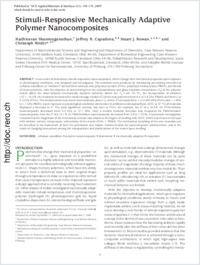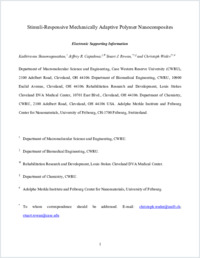Stimuli-responsive mechanically adaptive polymer nanocomposites
- Shanmuganathan, Kadhiravan Department of Macromolecular Science and Engineering, Case Western Reserve University, Cleveland, Ohio, USA
- Capadona, Jeffrey R. Department of Biomedical Engineering, Case Western Reserve University, Cleveland, Ohio, USA - Rehabilitation Research and Development, Louis Stokes Cleveland DVA Medical Center, Cleveland, Ohio, USA
- Rowan, Stuart J. Department of Macromolecular Science and Engineering, Case Western Reserve University, Cleveland, Ohio, USA - Rehabilitation Research and Development, Louis Stokes Cleveland DVA Medical Center, Cleveland, Ohio, USA - Department of Chemistry, Case Western Reserve University, Cleveland, Ohio, USA
- Weder, Christoph Department of Macromolecular Science and Engineering, Case Western Reserve University, Cleveland, Ohio, USA - Adolphe Merkle Institute and Fribourg Center for Nanomaterials, University of Fribourg, Switzerland
-
22.12.2009
Published in:
- ACS Applied Materials & Interfaces. - 2009, vol. 2, no. 1, p. 165–174
English
A new series of biomimetic stimuli-responsive nanocomposites, which change their mechanical properties upon exposure to physiological conditions, was prepared and investigated. The materials were produced by introducing percolating networks of cellulose nanofibers or “whiskers” derived from tunicates into poly(vinyl acetate) (PVAc), poly(butyl methacrylate) (PBMA), and blends of these polymers, with the objective of determining how the hydrophobicity and glass-transition temperature (Tg) of the polymer matrix affect the water-induced mechanically dynamic behavior. Below the Tg (∼60−70 °C), the incorporation of whiskers (15.1−16.5% v/v) modestly increased the tensile storage moduli (E′) of the neat polymers from 0.6 to 3.8 GPa (PBMA) and from 2 to 5.2 GPa (PVAc). The reinforcement was much more dramatic above Tg, where E′ increased from 1.2 to 690 MPa (PVAc) and ∼1 MPa to 1.1 GPa (PBMA). Upon exposure to physiological conditions (immersion in artificial cerebrospinal fluid, ACSF, at 37 °C) all materials displayed a decrease in E′. The most significant contrast was seen in PVAc; for example, the E′ of a 16.5% v/v PVAc/whisker nanocomposite decreased from 5.2 GPa to 12.7 MPa. Only a modest modulus decrease was measured for PBMA/whisker nanocomposite; here the E′ of a 15.1% v/v PBMA/whisker nanocomposite decreased from 3.8 to 1.2 GPa. A systematic investigation revealed that the magnitude of the mechanical contrast was related to the degree of swelling with ACSF, which was shown to increase with whisker content, temperature, and polarity of the matrix (PVAc > PBMA). The mechanical morphing of the new materials can be described in the framework of both the percolation and Halpin−Kardos models for nanocomposite reinforcement, and is the result of changing interactions among the nanoparticles and plasticization of the matrix upon swelling.
- Faculty
- Faculté des sciences et de médecine
- Department
- AMI - Chimie des polymères et matériaux
- Language
-
- English
- Classification
- Physics
- License
-
License undefined
- Identifiers
-
- RERO DOC 17172
- DOI 10.1021/am9006337
- Persistent URL
- https://folia.unifr.ch/unifr/documents/301437
Other files
Statistics
Document views: 103
File downloads:
- pdf: 369
- Supplementary material: 142

